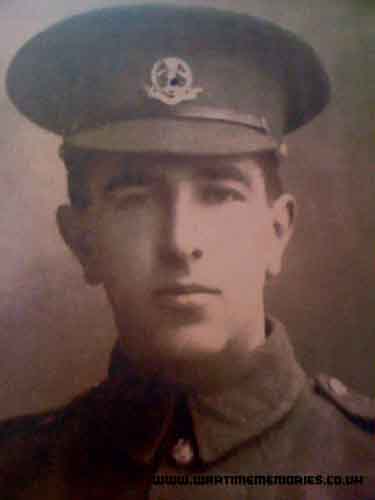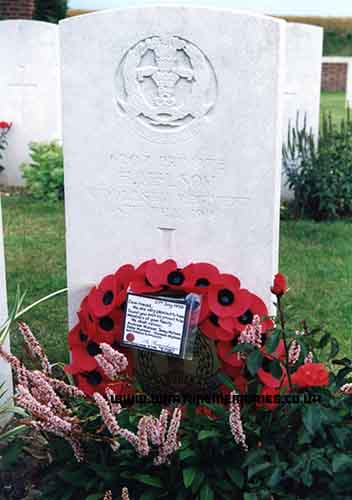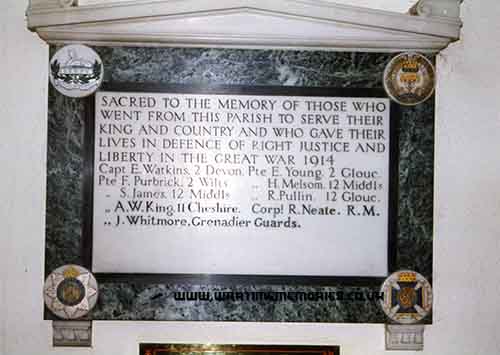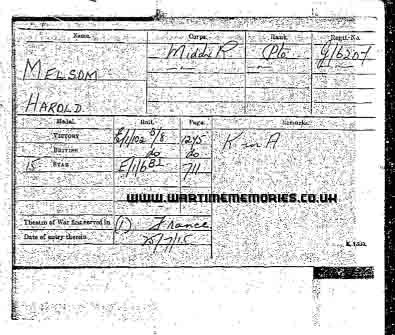Additions will be checked before being published on the website and where possible will be forwarded to the person who submitted the original entries. Your contact details will not be forwarded, but they can send a reply via this messaging system.
please scroll down to send a message
Pte. Harold Melsom
British Army 12th Btn. Middlesex Regiment
from:Castle Combe, Wiltshire
(d.5th Jul 1916)
Harold Melsom was born in Castle Combe, Wiltshire, 18th July 1890 and baptised on 7th September 1890, St. Andrew's Parish Church, Castle Combe, Wiltshire. He was killed in action at Mametz Wood, near Albert, Somme, Northern France, Wednesday 5th July 1916 during the Battle of the Somme which commenced on 1st July 1916. He had formerly served as 14334 Hussars of the Line (probably 10th Royal Hussars (Princess of Wales Own)). He was unmarried and lived in Bybridge Cottages, Castle Combe, Wiltshire. His father George Melsom, born 1851, died 3rd December 1918 was a Plasterer and Tiler. His mother, Elizabeth Sarah Melsom formerly Tylee, born 1853, Market Lavington, died 10th March 1914. Haolds sblings were: Albert born 1882, died 13th March 1942. Frederick born 1883, Died 22nd May 1943, Vancouver, Canada. Ethel Eliza born 1886, died ?
Harold Melsom is buried at Dantzig Alley C.W.G.C. Cemetery, which is east of Mametz, Somme, Northern France, Dantzig Alley was originally the site of a German trench.
Harold had a friend, Private Reginald Stanley James, also from Castle Combe, who died of wounds on the Somme on 1st July 1916 aged 22. He was the son of Mr. F. and Mrs. E. James of Castle Combe. Reginald is buried at Dive Copse C.W.G.C. Cemetery, which is north of Sailly-le-Sec, Somme, which is 20km east of Amiens, Plot 2, Row A, Grave 15, once the site of a main dressing station commanded by an officer called Dive. The dressing station was located behind the Cross of Sacrifice. Reg enlisted with Harold at Bristol (then in Gloucestershire), his service number in the 10th Hussars is consecutive to Harold's being 14335, so it is very likely they served together in both regiments.
They were both members of the 12th Middlesex (Service) Regiment (Duke of Cambridge's Own) known as 'The Diehards'. The regiment was formed at Mill Hill, London in August 1914. Harold enlisted at Bristol, Gloucestershire. In May 1915 the regiment moved to Codford on Salisbury Plain for training with respect to the imminent move to France (Codford St. Mary and Codford St. Peter are situated just off the A36 between Warminster and Salisbury in Wiltshire).
The 12th Middlesex Regiment subsequently sailed to France landing at Le Havre on 26th July 1915. On the 1st January 1916 under the command of Lt. Col. H. P. Osbourne, the regiment was billeted at Meaulte which is south east of Albert. On the 8th January 1916, the 12th Middlesex Regiment moved forward to the front line taking over the trenches in the D1 sector south of Fricourt (east of Albert). On the 5th March 1916 the battalion moved via Corbie (east of Amiens)and Bray sur Somme (south east of Albert) relieving the 2nd Battalion of the Wiltshire Regiment in the A1 sector. Lt. Col. Osbourne had been evacuated sick, and his Second in Command, Major M. C. Scarborough took over temporary command of the Regiment. On the 2nd April 1916, Lt. Col. Osbourne returned to the regiment and re-assumed command.
On the the 11th June the Regiment entrained at Mericourt (north east of Amiens) for Picquigny (north west of Amiens) where they trained in specially constructed trenches. They returned to Grove Town, Meaulte on the 26th June 1916. On the 28th June at 08:15 p.m. the 12th Middlesex Regiment moved from Bray sur Somme to Carnoy, taking over the front line trenches north of the village from the 7th Battalion of the Bedfordshire Regiment. On the night of the 30th June at 10:30 p.m. the Regiment was itself relieved by the 11th Battalion of the Royal Fusiliers, and the 12th Middlesex returned to dugouts at Carnoy. When the Battle of the Somme commenced on 1st July 1916, the 12th Battalion of the Middlesex Regiment was therefore waiting in reserve.
The Commanding Officer at the time of Harold's death was Lt. Colonel Frank Maxwell V.C., C.S.I., D.S.O. (Victoria Cross, Companion of the Order of the Star of India, Companion of the Distinguished Service Order). He had taken over command of the 12th Middlesex Regiment on the 31st May 1916. Lt. Col. Maxwell had won the Victoria Cross at Sanna's Post during the South African Campaign (Boer War) on the 31st March 1900. When Frank Maxwell was appointed Commanding Officer of the 12th Battalion Middlesex Regiment, his personality exerted a tonic effect upon the morale and fighting qualities of the Battalion. In temperament, and in every other attribute, physical and mental, Lt. Col. Maxwell was fitted for the task assigned to him. There was a steely quality in his personal bravery that seemed accentuated by the almost studied tranquillity of his speech and general manner.
Frank Maxwell was killed by snipers whilst reconnoitring in No Man's Land near Ypres, Belgium on 21st September 1917. At the time of his death he was a Brigadier General in command of the 21st Infantry Brigade of the 9th Division. He was aged 46 and is buried at Ypres Reservoir C.W.G.C. Cemetery, north west of Ypres, Belgium, Plot 1, Row A, Grave 37. A memorial to Brigadier General Frank Maxwell can be seen in St. Giles Cathedral in Edinburgh. He was the son of Thomas Maxwell M.D. and Violet Sophia Maxwell and the husband of Charlotte Alice Hamilton Maxwell.
The 12th Middlesex Regiment was a volunteer regiment and part of Lord Kitchener's 'New Army'. Volunteers such as Harold received one shilling per day. Conscription was introduced in the U.K. in January 1916, but initially only for batchelors.
The 12th Middlesex Regiment was an infantry regiment and formed part of the 54th Brigade along with the 11th Battalion Royal Fusiliers, 7th Battalion Bedford, and the 6th Battalion Northampton Regiments. The 12th Battalion of the Middlesex Regiment was eventually disbanded on the 13th February 1919.
The 54th Brigade was part of the 18th (Eastern) Division, New Army, commanded by Major General F. I. (Ivor) Maxse.
The 18th Division Headquarters was at Carnoy, and the Division formed part of XIII Corps. The Officers commanding the XIII Corps were:
General Officer Commanding: Lt. General W. N. Congreve V.C. Brigadier-General General Staff: Brigadier-General W. H. Greenly. Brigadier-General Royal Artillery: Brigadier-General R. St. C. Lecky.
The XIII Corps in turn formed part of the Fourth Army. The Fourth Army Headquarters was at Querrieux Chateau, which is north east of Amiens. The Officers commanding the Fourth Army were;
General Officer Commanding: General Sir Henry Seymour Rawlinson Bt. K.C.B. K.C.V.O. Major-General General Staff: Major-General A. A. Montgomery. Deputy-Adjutant and Quartermaster-General: Major-General H. C. Holman. Major-General Royal Artillery: Major-General C. E. D. Budworth. Chief Engineer: Major-General R. U. H. Buckland. Deputy-Director Signals: Colonel R. G. Earle.
The Commander in Chief of the British Army in France was General (later Field Marshall 1st Earl Haig of Bemersyde) Sir Douglas Haig. His Chief of Staff was Lt. General Sir Launcelot E ('Kigg') Kiggell, and the Major General of the Royal Artillery was Major General J. F. N. Birch. The General Headquarters for the British Expeditionary Force in France was at Montreuil near Etaples/Le Touquet. A statue still stands in the Town Hall Square at Montreuil, of General Haig on horseback, commemorating the fact that his General Headquarters were based in the town throughout the war.
The objective of the 18th Division at the Battle of the Somme which commenced on the 1st July 1916 was to capture a German trench called 'Montauban Alley' which ran to the rear and south of the village of Montauban. The Corps heavy artillery, combined with that of the French Corps on the right, was greatly superior to that of the Germans in this sector, by a ratio of nearly four to one. The course of the artillery barrage laid down that day would practically destroy the German Artillery.
On the 1st july 1916 the Battalion had a strength of 21 officers and 820 other ranks. The Second in Command to Lt. Col. Maxwell was Major M. C. Scarborough. the four Company Commanders were:
- A Company Captain L. H. Methuen
- B Company Captain G. L. Harrisan
- C Company Lieutenant A. E. West
- D Company Captain A. C. Davies
Saturday the 1st July dawned a very hot day. No smoke was laid down to cover the advance of the British Infantry. On the front of the 18th Division, two mines below the enemy's front trench at la Boiselle were fired at 07:27 a.m., while a flame-thrower had been set up to assist the assault on the right. At Zero hour the attacking battalions crossed No Man's Land against some opposition, running up against the main German resistance at their support trench and the castle. Fighting all the way, the infantry of the 18th Division pushed the Germans back trench by trench in a series of battles involving grenades, machine guns and bayonets.
By 08:30 a.m. most of the division's first objectives had been taken, but the enemy was stubbornly resisting in the centre. Nevertheless, an attack on the Pommiers Redoubt was launched, and this was taken after fierce hand-to-hand fighting.
The parties of German troops holding up the centre of the 18th Division's assault were by now becoming aware of the situation on their flanks, which had been well turned. Some began to fall back, some to surrender, but some remained to fight. Trench by trench the British advanced, until by late afternoon contact had been established with the 30th Division, and the whole of the 18th Division objective had been captured.
The day's fighting had cost XIII Corps just over 6000 casualties, but mercifully it was possible to evacuate the wounded speedily. Most of the wounded of the 18th Division were taken back to the village of Carnoy, and the village square was used as a casualty clearing station.
Throughout the first day of battle, the 12th Battalion Middlesex Regiment had been kept in dugouts in Carnoy. At 08:30 p.m. Lt. Col. Maxwell moved up to the Battalion Headquarters at Piccadilly in the old British front line. At 12:45 a.m. the Middlesex Regiment moved up into the forming-up trenches. Shortly afterwards crossing No Man's Land to the old German front line.
The Companies took up the following positions: A and B Companies each had two platoons in Bund Trench, and A Company two more platoons in Emden Trench on the right of the Triangle, and B Company had two more platoons in the same trench, but on the left of the Triangle; C company was in Austrian Support Trenches, and D Company in Austrian front line.
The enemy's barrage was still falling, but it was weak and not very accurate. On Companies taking up their positions, they began consolidating. The hostile trenches were much damaged and in places obliterated. Dead Germans were everywhere, and some prisoners taken from dugouts were obviously much shaken and almost incoherent. At this point one officer, 2nd Lieutenant R. H. Hudlestone was killed, two other officers wounded, three other ranks killed, 27 wounded and four missing.
There was little activity on Sunday 2nd July and the British Divisions were able to reorganize and reinforce as well as pushing forward supplies and ammunition.
During the daylight hours of the 2nd July, the 12th Middlesex Regiment remained in the same positions. At 08:30 p.m. the Battalion was ordered to relieve the 11th Royal Fusiliers in the advanced trenches. Companies took up the following postions: A Company in White Trench, B and C Companies in Beetle Alley, and D Company in Maple Trench from the junction of Black Alley to Strong Point No. 5 inclusive. Lt. Col. Maxwell's headquarters were in Black Alley. The relief was completed by about 01:30 a.m. on Monday 3rd July. Casualties that day were one officer and four other ranks wounded. The 12th Battalion of the Middlesex Regiment was now south of Caterpillar and Mamtez Woods.
XIII Corps spent Monday 3rd July in consolidation. Patrols discovered Bernafay Wood to be still undefended, and at 09:00 p.m. supported by a 20 minute barrage, two battalions of the 9th Scottish Division, New Army, entered and took possession of the wood. Throughout the 3rd July the 12th Middlesex Regiment remained in the same positions, all Companies consolidating the line. In the evening B and C Companies set to work to dig a communication trench between White Trench and Beetle Alley. The enemy shelled both the latter trenches during the day, but his shell fire was weak and not very effective: 2nd Lieutenant Souster and two other ranks were wounded. At night D Company was withdrawn from Maple Trench and took over Strong Points from the 6th Northamptonshire Regiment.
The weather, which had been fine apart from the occasional thunderstorms, broke on Tuesday 4th July. Heavy rain filled the trenches and turned tracks into quagmires. The shell torn ground absorbed the downpour, melting tracts of marshland. The 4th of July passed without incident, but during the evening the dispositions on the Companies were again slightly altered: A Company remained in White Trench, B Company was in Montauban Alley, between Caterpillar Trench, and Pommiers Redoubt, with four strong points in the Caterpillar Trench, one at the junction of Loop Trench and Montauban Alley and one at White Trench. These posts were garrisoned with one Vickers gun and section.
Caterpillar Wood, reported empty by the Royal Flying Corps, was occupied by the 18th Division on the 4th July and the division also recovered five abandoned German field guns while taking possession of a section of enemy trench near the wood. C Company, 12th Middlesex Regiment was in Caterpillar Wood with two sections and one Vickers gun. D Company was in Pommiers Trench with a strong point at the loop. By nightfall troops of the 18th Division had occupied Marlboro Wood, 500 yards beyond Caterpillar Wood. The 12th Middlesex now held part of the 53rd Brigade front as well as the front line of their own Brigade, the 54th.
According to the official regimental history of the 12th Battalion the Middlesex Regiment, 'Diehards in the Great War', a copy of which is available for reading at the Imperial War Museum, Wednesday 5th July, the day Harold Melsom was killed, was a quiet day with little enemy action. Only the occasional enemy shell bursting overhead, though hostile shelling was at times heavy. Patrol work was carried out each night. It is though at present that Harold was killed by an enemy shell or shrapnel. It may be possible to learn more on our visit to the cemetery in France. Often in a book kept at the cemetery, a description is given of how the person died and also can often be found a personal message from the next of kin. Next of kin were also permitted a single line message on the headstone and again it will be interesting to see if this was done.
The Middlesex Regimental museum at New Malden in Surrey was closed in 1992 on the death of the curator (information can be obtained on 0181 949 7605). All artifacts were transferred to the National Army Museum in Chelsea where several showcases are dedicated to the Middlesex Regiment. Other items of interest have been spread throughout the museum.
The Middlesex Regiment was amalgamated in 1966 to form the Queen's Regiment with other home counties regiments. This was also later amalgamated to form The Princess of Wales Royal Regiment based at Howe Barracks, Canterbury, Kent. The Regimental museum is at Dover Castle and a display here includes several items from the Middlesex Regiment. However there are few items of interest.



